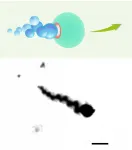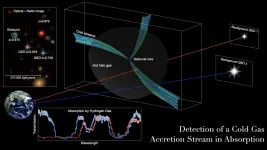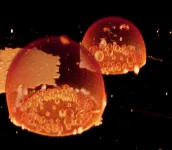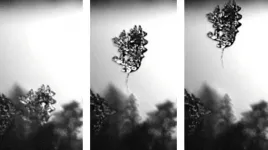(Press-News.org) URBANA, Ill. ¬- In today's global economy, production of goods depends on inputs from many trade partners around the world. Companies and governments need a deeper understanding of the global value chain to reduce costs, maintain a profitable production system, and anticipate ripple effects of disruptions in the supply chain.
Applied economists from the University of Illinois have developed a new model for in-depth analysis of global supply chain linkages across countries and industries, providing a rich tool that delivers valuable insights for businesses and policy makers around the world.
"We live in a time when production processes are very much fragmented. In order to end up with one type of good, a car for example, many inputs are assembled abroad and imported from different places around the world. For instance, a car sold by leading U.S. companies may have anywhere from just 2% to 85% of U.S. and Canadian parts in it," says Sandy Dall'Erba, professor in the Department of Agricultural and Consumer Economics and director of the Regional Economics Applications Laboratory (REAL) at U of I. Dall'Erba is co-author of the study.
"Coordination of the entire supply chain system becomes more and more complicated and sensitive to disruptions at any stage throughout the process. If just one element in your supply chain is missing, it will have a ripple effect on the entire industry," Dall'Erba notes. "An example of this was the global semiconductor shortage that recently forced U.S. automakers to halt production."
The researchers started with a widely used economic growth model called shift-share decomposition and expanded its components to include interregional and inter-sectoral linkages. This allows them to identify, for each industrial sector and each country, if the growth of the sector of interest is due to supply chain linkages at the domestic level versus the international level. The latter can be further split between linkages with trade agreement partners (such as NAFTA for the U.S.) and countries from the rest of the world, highlighting the benefits of trade agreements.
"When we apply our technique to understand the drivers of growth in a particular sector, we not only can say whether it is growing faster or slower than another sector or region, we can also identify other sectors that are important for the growth of this particular sector," says Claudia Montania, the study's lead author. Montania was a visiting scholar in REAL when she conducted the study and is currently a researcher at the United Nations Development Accelerator Lab in Asuncion, Paraguay.
Traditional shift-share decomposition includes information about changes in the industry mix and in region-specific features such as taxes, regulations, or characteristics of the labor force. But it does not include connections among different regions or different industry sectors.
"The information provided by the traditional shift-share model is not enough," Dall'Erba notes. "For example, it would be a mistake to study only the food manufacturing sector in order to know what is happening in that sector, because it obviously depends on grain and livestock production which, in turn, depends on water and fertilizers among other inputs.
"In addition, grains are not always used for food manufacturing but they may end up as fuel. The supply chain of any sector is intertwined with that of many other sectors," he adds.
In the paper, Dall'Erba and Montania apply their model to country-sector linkages in the European Union, allowing them to compare three levels of connections - domestic, within the EU, and with the rest of the world, and to identify which ones matter most for each sector. The analysis included 35 industrial sectors in 15 countries from 1995 to 2006.
Overall, the researchers found the most important linkages were among EU trade partners; the second-most important were domestic ties; and the least important linkages were with the rest of the world. They emphasize the results vary across sectors and countries. For example, the supply-chain linkages in place to manufacture a French car are different from those that exist for a German car. Their multi-dynamic model can provide detailed, specific information for each country-sector combination as needed for preemptive and tailored planning and policy making.
"Knowing which type of linkages are the most important for your product or your sector can be very useful for local governments, for companies, and for producers, because you can make better plans to achieve the expected growth for your sector," Montania states. "You can also promote trade and diplomatic relationships in regions where you have strong sectoral linkages."
Dall'Erba points out this information can help countries and industries protect against supply chain disruptions. Those can occur in many forms, ranging from natural disasters such as drought or earthquake to political upheaval, trade wars, and even the global pandemic. For instance, the extreme disruption airline companies have experienced as demand for air travel dropped in 2020 means both Boeing and Airbus have significantly reduced their production and so have the multiple companies manufacturing airplane components from fuselage to seat belts.
"COVID-19 has pushed several governments to consider bringing back some industries in order to get better control over all the supply chain links. However, it is not necessarily a viable option as many companies have already de-located their unskilled labor-intensive production to low-wage countries while maintaining high-skilled workers at home," Dall'Erba concludes.
INFORMATION:
The Department of Agricultural and Consumer Economics and the Regional Economics Applications Laboratory (REAL) are in the College of Agricultural, Consumer and Environmental Sciences, University of Illinois.
The paper, "Multi-dynamic interregional input-output shiftshare: model, theory and application" is published in Economic Systems Research. Authors include Claudia Montania and Sandy Dall'Erba.
[https://doi.org/10.1080/09535314.2020.1867078]
Researchers have developed a method to estimate the value of oyster and clam aquaculture to nitrogen reduction in a coastal community. Nitrogen is a nutrient that comes from many different sources, including agriculture, fertilizers, septic systems, and treated wastewater. In excess it fuels algal growth, which can affect water quality and human health.
As a result, a growing number of communities are required to follow regulations to reduce the amount of nitrogen they release. Shellfish are an option that can be a valuable part of a community's nutrient management plan.
In a study in Environmental Science ...
A UNSW Sydney-led medical research team has called for a new vaccine, improved strategies and enhanced monitoring to combat serious complications from childhood pneumonia.
The researchers examined the impact of the 13-valent pneumococcal conjugate vaccine (13vPCV) on childhood pneumonia and empyema - complicated pneumonia - after its introduction to the Australian National Immunisation Program about a decade ago.
The new study, published in Thorax recently, found that while 13vPCV resulted in a 21 per cent decrease in childhood pneumonia hospitalisations, there was a contemporaneous 25 per cent increase in admissions for empyema.
This incidence data for childhood empyema hospitalisations is similar to that reported ...
For many, 2020 was notorious for the COVID-19 pandemic, but for climate scientists, the year is also infamous for tying with 2016 as the hottest since records began. 'Nine of the warmest years on record have occurred since 2010', says JEB Editor-in-Chief, Craig Franklin. With the ice caps and glaciers melting, devastating bushfires scorching arid regions, and hurricanes and typhoons battering coastal communities, the impact on local ecosystems has been catastrophic. 'Physiologists can play a critical role in the conversation around climate change', says ...
As part of the Journal of Experimental Biology's Special Issue dedicated to climate change, Anthony Pagano (San Diego Zoo Global, USA) and Terrie Williams (University of California, Santa Cruz, USA), discuss the impact of environmental change on two iconic polar species; the polar bear and narwhal. Their review article is published in Journal of Experimental Biology at https://jeb.biologists.org/content/224/Suppl_1.
Mammals in the Polar Regions face an uncertain future as unprecedented warming drives catastrophic sea ice loss, driving polar bears onto land, after losing access to sea ice and ...
Rheumatoid arthritis is a chronic inflammatory disorder marked by joint pain, swelling and damage. Although medications, such as steroids, anti-inflammatory drugs and immunosuppressants, can help slow joint destruction and relieve pain, they have side effects and aren't completely successful. Now, researchers reporting in ACS' Nano Letters have developed magnesium-based micromotors propelled by hydrogen bubbles, which improved rheumatoid arthritis symptoms when injected into the joints of rats.
Scientists have linked rheumatoid arthritis development to the excess production of reactive oxygen species (ROS). ROS can oxidize and degrade cartilage and bone, as well as activate the expression of inflammatory cytokines. A new type of therapy, hydrogen gas, can neutralize ROS ...
To come into being, galaxies need a steady diet of cold gases to undergo gravitational collapse. The larger the galaxy, the more cold gas it needs to coalesce and to grow.
Massive galaxies found in the early universe needed a lot of cold gas--a store totaling as much as 100 billion times the mass of our sun.
But where did these early, super-sized galaxies get that much cold gas when they were hemmed in by hotter surroundings?
In a new study, astronomers led by the University of Iowa report direct, observational evidence of streams of cold gas they believe provisioned these early, massive galaxies. They detected cold gas pipelines that knifed through the hot atmosphere in the dark matter halo of an early massive galaxy, supplying the materials ...
New research by the University of Oslo provides evidence that the "protocells" that formed around 3.8 billion years ago, before bacteria and single-celled organisms, could have had specialized bubble-like compartments that formed spontaneously, encapsulated small molecules, and formed "daughter" protocells.
ROCKVILLE, MD - Scientists have long speculated about the features that our long-ago single-celled ancestors might have had, and the order in which those features came about. Bubble-like compartments are a hallmark of the superkingdom to which we, and many other species including yeast, belong. But the cells in today's superkingdom have a host of specialized molecules that help make and shape these bubbles inside our ...
ATLANTA - FEBRUARY 24, 2021 - New study reports that early in the 2020 pandemic in the United States, one-third of cancer survivors worried about treatment and cancer care disruptions. Using a mixed methods approach, investigators utilized survivors' own words to more deeply describe their experiences and worries about the pandemic's impact on their overall health.
The article, appearing in the Journal of Psychosocial Oncology, finds the impact of the pandemic on cancer survivors and the broader health care system is widespread and exacerbated serious gaps in the health care system. For this study, investigators led by Corinne Leach, MPH, MS, PhD, from the American ...
If you have ever gotten up on a winter morning and thrown yourself into the arduous task of scraping frost from a windshield, a Virginia Tech lab is engaging science [IS1] that could make your life much easier. In research funded by the National Science Foundation, Associate Professor END ...
DALLAS, Feb. 24, 2021 -- Postmenopausal women who ate high levels of plant protein had lower risks of premature death, cardiovascular disease and dementia-related death compared with women who ate less plant proteins, according to new research published today in the Journal of the American Heart Association, an open access journal of the American Heart Association.
Previous research has shown an association between diets high in red meat and cardiovascular disease risk, yet the data is sparse and inconclusive about specific types of proteins, the study authors ...




